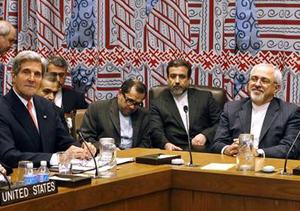
John Kerry, the US Secretary of State, and Javad Zarif, the Iranian regime’s Foreign Minister are due to meet in Geneva this weekend. The talks will be part of the ongoing effort to achieve a comprehensive agreement regarding the nuclear program in Tehran.
It is essential to the deal that inspection and verification visits preventing Iran from obtaining nuclear weapons are allowed. The Obama administration still upholds the opinion that the nuclear deal will block the path of the regime to the bomb according to the NCRI.
On Friday, the UN Atomic Agency reported that an assessment of the allegations that Iran is working on atomic arms, an important element to the deal, has currently stalled. The IAEA are focusing on 12 activities that indicate that the clerical regime is attempting to manufacture nuclear weapons and are involved in activities surrounding the development of a nuclear payload for missiles.
In its November 2011 report the UN listed the unresolved issues in relation to “Possible military dimensions” of Iran’s nuclear program.
In November 2014, “In Search of Justice”, a renounced Brussels-based NGO, reported that a thorough review and study of the 12 disputed issues showed that civilian and military aspects of the Iranian nuclear program act like two concentric circles. They also reported that the civilian program is at the service of the military program.
“Iran has yet to propose any new practical measures” since August that will advance the investigation the IAEA report stated.
This report that was issued to the agency’s board of 35 nations and the UN Security Council claimed that it is still “concerned about the possible existence in Iran of undisclosed nuclear-related activities involving military-related organizations, including activities related to the development of a nuclear payload for missiles”.
The IAEA also stated that it is still essential for Iran to respond to their questions about Parchin military base. It is here that Western officials suspect Tehran has conducted explosives tests relevant to nuclear bombs. Access to the site is also as important.
On Thursday, the People’s Mojahedin Organization of Iran (PMOI/MEK) revealed that the Iranian regime and North Korea’s government, as recently as late April 2015, have extensively exchanged information and delegations of experts in the fields of nuclear weapons and nuclear warhead design.
A North Korean delegation which included nuclear warhead experts, and several other experts in elements of ballistic, were present in the country for a week towards the end of April. Another delegation comprising of nine experts is scheduled to arrive in Iran from North Korea in June.
The National Council of Resistance of Iran revealed the existence of a secret site, “Lavizan-3”, on February 24th this year. Information provided by the Iranian opposition indicates that Iran has been secretly enriching uranium there using advanced centrifuges, for several years.
With information amassed by the PMOI (MEK) network, the NCRI have been able to expose some of the most important aspects of the clerical regime’s nuclear weapons program. In particular, the Natanz uranium enrichment and the Arak heavy water facilities, the Kalay-e Electric centrifuge assembly and testing facility, the Lashkar-Abad laser enrichment facility, the Lavizan-Shian site, the Fordo underground enrichment site and the Defensive Innovation and Research Organization (solely responsible for coordinating the Iranian military nuclear program).
Before the NCRI revealed these sites and programs, all were kept secret by the regime.
Several officials in Iran, including the supreme leader, Ali Khamenei, have openly denied IAEA inspections of military sites. They have also denied interviews with nuclear scientists that are involved in concealed nuclear weapon efforts. Western powers have rejected Iran’s ruling out of inspections of their military bases.
It is essential that spot inspections to any of the military and non-military sites at any time are allowed. It is also essential that the regime are accountable for any military dimensions of its nuclear projects and that they provide access, without conditions, to the regime’s nuclear specialists, according to the NCRI.


